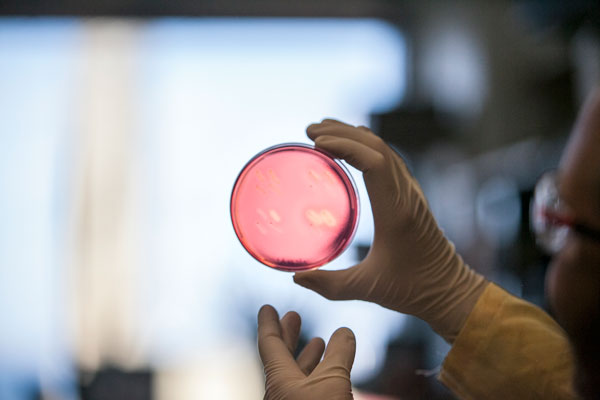
Postdoctoral researcher Rembrandt Haft holds up an agar gel plate to the light. The faded portions of the gel show where bacteria have degraded its cellulose.
At the Great Lakes Bioenergy Research Center, we’ve spent five years pursuing a diverse set of approaches and utilizing a wide range of tools and expertise that will help us create new technologies for producing advanced biofuels. Rather than focus exclusively on one approach, our researchers are exploring multiple processes — ranging from oil extraction to both alkaline and acid pretreatment strategies — that can create new value streams for intermediates like specialty chemicals and end products like fuel.
As we’ve matured, we’ve increased our focus on areas that the biofuels industry categorizes as obstacles. When Great Lakes Bioenergy research sheds light on a widespread problem, we can have an impact on multiple points throughout the biofuels landscape.
One obstacle for the biofuels industry is lignin, and we’ve made important advances that will reduce the energy needed to utilize this promising source of fuels and chemicals. By applying unique alkaline pretreatment strategies, we hope to harness a reliable lignin stream, which opens up tremendous possibilities for valuable co-products–materials that can add value to the biofuels pipeline (read "Spinning Straw into Gold with Co-Products").
From a biological perspective, we’re taking a close look at what stressors keep microbes from doing their jobs effectively. We know there are many sources of microbial stress, and going forward, we’ll continue to focus on them using genomic tools to gain insight into how to give microbes the ability to handle those stressors.
At the landscape scale, GLBRC sustainability researchers have been concerned from the start about how to introduce bioenergy crops into the landscape without causing unintended environmental, economic or social consequences. One possible and promising solution is the use of marginal lands. Combining agronomic expertise with massive modeling power, our researchers have confirmed that enough marginal lands exist in the Midwest alone to provide annually 25 percent of the Energy Independence and Security Act requirement (read the "Availability of Marginal Lands" sidebar).
This year was filled with exciting progress in both basic and applied research. Over the summer we marked an important Center milestone: our first issued patent. In the fall, we celebrated the first license on a GLBRC technology. Using ionic liquids to break down cellulosic biomass into fermentable sugars, the technology will be developed by biotechnology startup Hyrax Energy, the first company to emerge from GLBRC research (read our "Collaboration, Technology and Commercialization" section).
In this year’s report, we hope you’ll enjoy learning more about our scientific achievements, the people behind our research (read "Getting to Know Our Team: Four Conversations"), and our plans for the years ahead.